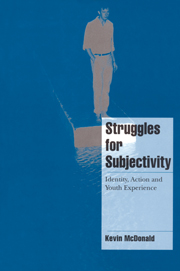Book contents
- Frontmatter
- Contents
- Acknowledgements
- Research participants
- 1 Introduction: subjectivity and social experience
- PART I The end of a working-class experience
- PART II Postmodern crisis: navigating the flow
- 7 None of the above: contemporary experiences of the gang
- 8 You'll be forgotten: visibility and mobility of graffiti writers
- 9 Between the body and the self: the anorexic terrain
- 10 We stand up for what we are: ethnicity and Aboriginality
- 11 Conclusion: struggles for subjectivity
- Bibliography
- Index
- Title in the series
10 - We stand up for what we are: ethnicity and Aboriginality
Published online by Cambridge University Press: 05 December 2011
- Frontmatter
- Contents
- Acknowledgements
- Research participants
- 1 Introduction: subjectivity and social experience
- PART I The end of a working-class experience
- PART II Postmodern crisis: navigating the flow
- 7 None of the above: contemporary experiences of the gang
- 8 You'll be forgotten: visibility and mobility of graffiti writers
- 9 Between the body and the self: the anorexic terrain
- 10 We stand up for what we are: ethnicity and Aboriginality
- 11 Conclusion: struggles for subjectivity
- Bibliography
- Index
- Title in the series
Summary
Since the 1980s one of the most important social and cultural developments has been the reaffirmation of ethnic and racial identities, leading to a situation where older forms of social organisation based on assimilation have largely given way to a new acceptance of cultural diversity. But there are important issues at stake, with new uncertainties. The end of societies based around the integration of the nation-state and industrial economy, and the shift from a social model of hierarchy to one of mobilisation, involves new imperatives and has brought new forms of social exclusion. As Douglas argues, those threatened with loss of place in a society of mobilisation are also threatened with an absence of identity (1992: 35). The increasing importance of identity can be seen as double-sided – it is a resource that actors mobilise, and a form of stigma that is imposed. Ethnicity may be claimed but it may also be imposed, it may be a vehicle of mobilisation or an expression of crisis.
In this chapter, we explore dimensions of this ethnic and racial experience in the light of the frameworks that have been constructed thus far. We encounter the multiple dimensions of the experience of young immigrants in Melbourne, focusing on young Asian people. Research sessions were held with three groups: a multicultural group of students, a group of three young Vietnamese men, and a group of young Cambodian women.
- Type
- Chapter
- Information
- Struggles for SubjectivityIdentity, Action and Youth Experience, pp. 180 - 201Publisher: Cambridge University PressPrint publication year: 1999

